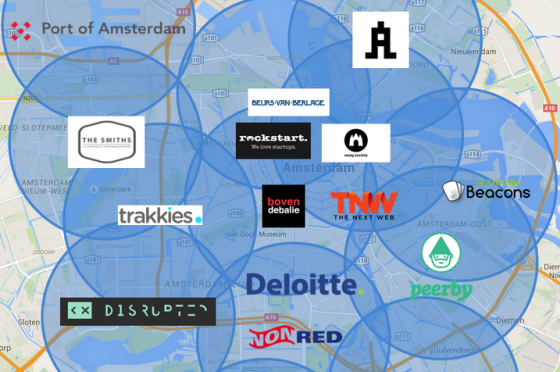Locating your bike, feeding the cat: Dutch start-up boosts the Internet of Things
 At the end of last year, Dutch start-up The Things Network raised €295,000 through a crowdfunding campaign to launch an open, free and decentralised internet of things network. Esther O’Toole finds out more.
At the end of last year, Dutch start-up The Things Network raised €295,000 through a crowdfunding campaign to launch an open, free and decentralised internet of things network. Esther O’Toole finds out more.
Imagine a house in which the plants alert you when they need watering or your cat is automatically fed. Then take it wider, across your neighbourhood and your city.
The Internet of Things is a network of physical objects, or things, which have been equipped with software, sensors and network connectivity. This enables them to collect and exchange data and improve the way they work, bringing greater efficiency and economic benefits.
Philips
The idea behind the Internet of Things (IoT) first came about in the 1990s when the board of Dutch electronics giant Philips, together with American innovators, coined the term ‘Ambient Intelligence’.
Ambient Intelligence refers to electronic environments equipped with devices that are sensitive to the presence of people, can sense change and relay information to a base – independent of human control. The theory went that the instruments themselves, working in chorus, would support a more convenient, efficient, life-enhancing world for humans; and become reality between 2010 and 2020.
Last year Wieke Giezeman, a serial start-up entrepreneur, launched The Things Network. The aim: to set up an IoT communication network throughout Amsterdam. He laid out his plans for citywide coverage, set up by and for users, with LoRa Wan (Long Wave Radio) gateway boxes which the company would produce themselves at low cost. Much to his astonishment it was fully crowdfunded and operational within six weeks.
‘We did it because we can. We believe in an open and free internet,’ Giezeman said. ‘The hardware is cheap enough. With this anyone can set themselves up. You don’t even need coding skills.’
Vision of the Future
LoRa Wan is the same kind of tech that telecoms giants such as KPN and Vodafone are hoping to exploit in order to profit from the need for a reliable IoT network.
‘If we leave this task up to big telcos, a subscription model will be enforced and we will exclude 99% of the cool use cases,’ says Giezeman. ‘Instead, let’s make it a publicly owned and free network so businesses and use cases will flourish on top of it.’
‘In future everything will be connected. A lot of data will be collected to make our lives better. It will allow service providers, of all sorts, to make their services cheaper and better for us, the consumers.’
Since the launch the idea has rapidly gone global. Over 20 cities (from Rotterdam, Eindhoven and Almere to Sao Paulo and Montevideo) are now taking part, 2,000 people are actively seeking to help, and 200 are specifically looking to set up their own local network.
In November, The Things Network launched a second Kickstarter campaign to try and support global roll out.The main aim is to have a network in every major city by the end of 2016. From then on it will need to grow via local communities. They succeeded in raising €295,000, more than €100,000 over their target.
So, how does it work?
IoT devices don’t need the constant internet access of your laptop. However, they do need consistent coverage, to be reliable in varied environments, safe from hacking and have long battery life in order to transfer data as and when they need to.
‘LoRa Wan has a range of up to 10 kilometres, low bandwidth and the battery use is very low. This is perfect for machine-to-machine communication,’ Giezeman explains.
By producing their own hardware, he and his team have worked hard to make options for different budgets: starting with The Things Gateway, a €200 version, with a range of five kilometres, allowing citizen users to contribute to the network from their own home.
Users have been quick to start using the network, designing tools that can link to it. As an Amsterdam-born idea it’s not surprising that these uses include intelligent sensors that alert you if your boat begins to take on rain water past a safe level for staying afloat. Or a device that locates your bike among the hoards of others parked outside the city’s main railway station.
Practical uses
The city’s port authority and successful sharing startup Peerby have also joined the enthusiastic user crowd. Outside cities, IoT trackers are already being used to monitor rhinos in the wild. In the home, uses could include remote thermostat, cctv or baby monitor control.
Some of these are essentially familiar and perhaps don’t seem like such a breakthrough change from apps. However, Giezeman and IoT innovators like him are anticipating the next stage of development being where the IoT will really take flight.
‘When I talk to people outside tech, in operations for instance, within ten minutes almost everyone can think of new uses. You just need to think of how far digital tech has come in the last thirty years and try and project forward.’
Thank you for donating to DutchNews.nl.
We could not provide the Dutch News service, and keep it free of charge, without the generous support of our readers. Your donations allow us to report on issues you tell us matter, and provide you with a summary of the most important Dutch news each day.
Make a donation